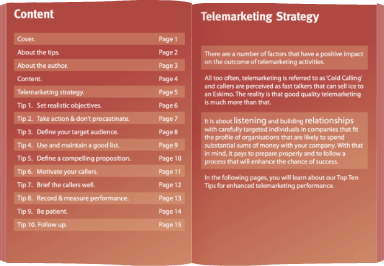What are the Key Steps for Telemarketing Campaign Preparation?
Not least with the potential risk of a looming recession, we are all under pressure to generate sales. We all want to see a sales pipeline full of the right kinds of leads. We need to get on enough PSL’s (preferred supplier lists) to drive growth, and to see enough prospective clients to stack the odds in our favour.
Yet, in many businesses, a lack of momentum in the sales process scuppers business objectives. A past over-reliance on marketing activity to generate inbound leads means that sales personnel risk taking their foot off the gas in terms of the level of proactive activity needed to generate fresh business opportunities. That can be particularly damaging if business slows down.
More Activity is Required
Does that sound familiar? Ultimately, companies need more activity to deliver more leads to fill the sales pipe. That’s not to say that any activity is good activity. There’s no point travelling down a road in the wrong direction. That situation is something that I believe many of us can relate to with our own sales teams. Let’s face it, business development is far from easy.
So, if outbound lead generation is on your agenda, this blog will provide a few pointers that should help when it comes to preparation for your sales campaigns using the telephone. You can also check out more tips that I use when providing telemarketing skills training.
Planning for Calling
When planning prospect calls, there are many things to consider. Even if your calls seem as plain and simple as any activity could get, it will still require a degree of preparation. A conversation with your perfect prospect that falls flat on its face is something every sales professional would like to avoid at all costs. And, no one wants to be perceived as the worst kind of insistent cold caller with poor technique that risks damaging your company reputation.
Yet, many telemarketers are ill-prepared, perceived as annoying and unprofessional, and they lose their way during calls. That’s because their planning and preparation are inadequate. Calling activity should be well orchestrated in advance and not left to chance.
Campaign plans should include:
- Strategy and approach
- Understanding the audience
- A good target list from which to call
- A CRM set-up that facilitates quick and effective calling
- A tailored approach including what to say
- Gatekeeper handling techniques
- Methods to handle objections
- KPIs and measurement
- Goals for the call and the campaign overall
It’s pretty unlikely that your prospective customers will jump into your arms straight away. They may have other priorities, incumbent suppliers, and they simply may not need what you offer.
So, here are the most important things to remember to prep before your calling campaign:
Be Clear About Your Strategy?
You need to think about your strategy ahead of time. It is certainly better than having to make things up on the spot. Lack of clarity regarding your campaign, not least related to your audience and your message will, almost certainly, lead to failure. Poor selection of prospect lists alongside an ill-conceived proposition definitely won’t lead to a full sales funnel.
If you’re uncertain regarding either of these elements, and you keep chopping and changing, your approach when on the phone won’t sound as tight and compelling as you need it to be. That’s because most callers find it difficult to come up with effective messages and responses off the cuff. Consistency supports momentum and familiarity, which are both essential for productive call sessions.
Understanding the Audience
Most sales teams would probably argue that they know their target audience. After all, they’re specialists in their field. They generally don’t lack experience. They keep up to date using trade magazines and other online resources, all the time. They’re constantly engaging with customers. They have had product training. Most understand what the proposition is and think they know how to sell it. Surely, therefore, it’s just a numbers game. There shouldn’t be anything else to it.
Yet, for many sales people, schooled in the old way of selling, the problem is that whilst they know all of the elements of what is required, how they put these together can impede successful selling. Ultimately, it is not so much about understanding the dynamics of a sector and grasping what your company offers. It is much more about identifying what challenges you solve for the customer and articulating these in terms of genuine benefits as opposed to features. Then, and only then, it’s about putting in the hard yards in order to reach, and engage with, your audience.
Build a Good Target List
Identifying the companies that are going to be most receptive to your product/service seems simple and logical. Yet, when you purchase a list from a list broker/owner, or compile your own database, remember, no list is perfect. The data is only as accurate as of the date the information was gathered and/or last verified. This may mean you will have an element of data cleansing/validation in advance of or during your calls.
If your target decision-maker role is niche, those job titles may not be found on most data broker lists. This may result in additional work to identify and isolate the right person. Rather than slowing the calling down by being blocked by no name policies, or through needing to Google or go on LinkedIn, it makes sense to factor data cleansing into your prep time. There’s nothing worse than planning to spend seven hours prospecting to generate interest in your next product launch/seminar when in actual fact you need to spend 60% of those hours researching the correct names.
A CRM System to Supports Callers
You need your callers to be productive. Anything that slows them down will reduce their outcomes. If telemarketers need to use multiple screens (or heaven forbid, spreadsheets) to find and record information, this will reduce their productivity.
Call speed and throughput will plummet when workflow isn’t built into your systems. Ideally, everything should be on one page. It should be intuitive and enable callers to prioritise calls and to schedule follow-ups with ease.
Whilst an investment in a good CRM may be something that is a considered purchase, if calling is a key part of your marketing outreach, these will be funds well invested.
Decide in Advance What to Say
Having something to help you crystallise the message you are going to deliver to prospects is critical to the success of your telemarketing campaign. Different sectors, and different roles, have different motivations. You need to be able to adapt your stance to what drives their purchase behaviours. An FD and an MD will have different needs to the Marketing Director. This needs to be reflected in messaging.
I am not a fan of scripts. I find them stiff and robotic. However, even if you have to streamline your opening statements to a certain extent, this will help you ensure you don’t beat around the bush, and that you have something succinct and compelling to say. If your opening gambit fails to cover the “what’s in it for me” concern, then save your breath and don’t say it.
Don’t be Surprised by Gatekeepers
It should not come as a surprise that you will encounter gatekeepers. The higher up you go in terms of company size and decision-maker role, the more of them you will meet. We’ve talked about planning what you will say to the decision-maker. The same should apply to the gatekeepers whose aim is often to block you. So, have something up your sleeve that will help you overcome these roadblocks. You can check out some gatekeeper techniques here.
Keep control, don’t make your pitch to someone that is not equipped to make a decision or buy from you. Your aim should be to get through to the person who writes the cheques!
Don’t Let Objections Stop You
Objections are a fact of life for those using the phone as a means of building their sales pipeline. As a consequence, like the other elements in this blog, you need to plan for them. Some objections are obvious. The fact that they are currently supplied by a competitor shouldn’t be a shock. Many prospects will have other priorities. Budgets are tight.
Brainstorming typical objections and planning for these, and other typical blocks, will ensure that your team improves its hit rate when it comes to dealing with inevitable barriers to doing business.
The Importance of KPIs
Ratios are important when it comes to improving the success of your outbound calls. Benchmarks enable you to measure and compare performance. Your company has objectives and targets to hit. It’s likely that every manager and employee has core objectives. The same applies to telemarketing. Work out your statistics and work to improve them.
Typical top-line measurements, for which you can establish ratios, include:
- Number of calls over a given timeframe
- Decision-maker contacts
- Leads created
Your business may have additional KPIs and it’s important to keep track of how each member of the sales team performs against your historic benchmark and against the expectations for the specific campaign.
Have a Goal in Mind
You need to know where you are going with your call. When running training, I hear so many calls that meander with no outcome in sight. At the end of the call, they just evaporate. There is no basis for follow up.
Most of us live in a goal-oriented world. That’s particularly the case for sales people. Qualification is essential since not every lead will fit your criteria and not every prospect will have the funds to purchase your products or services. Many won’t be in the market at the time of your call and will require a call-back.
Therefore, whether the objective is to establish a future need alongside an agreed date to call back, or an immediate demo or lead based on your chosen profiling criteria, you need to have a goal in mind. Without one, your prospect bank will shrink to nothing.
Without campaign preparation at management level, callers will be left to their own devices and will often flounder. Clarity of direction is essential and business that use the telephone as part of their business development must provide the best possible environment for the campaign to succeed






